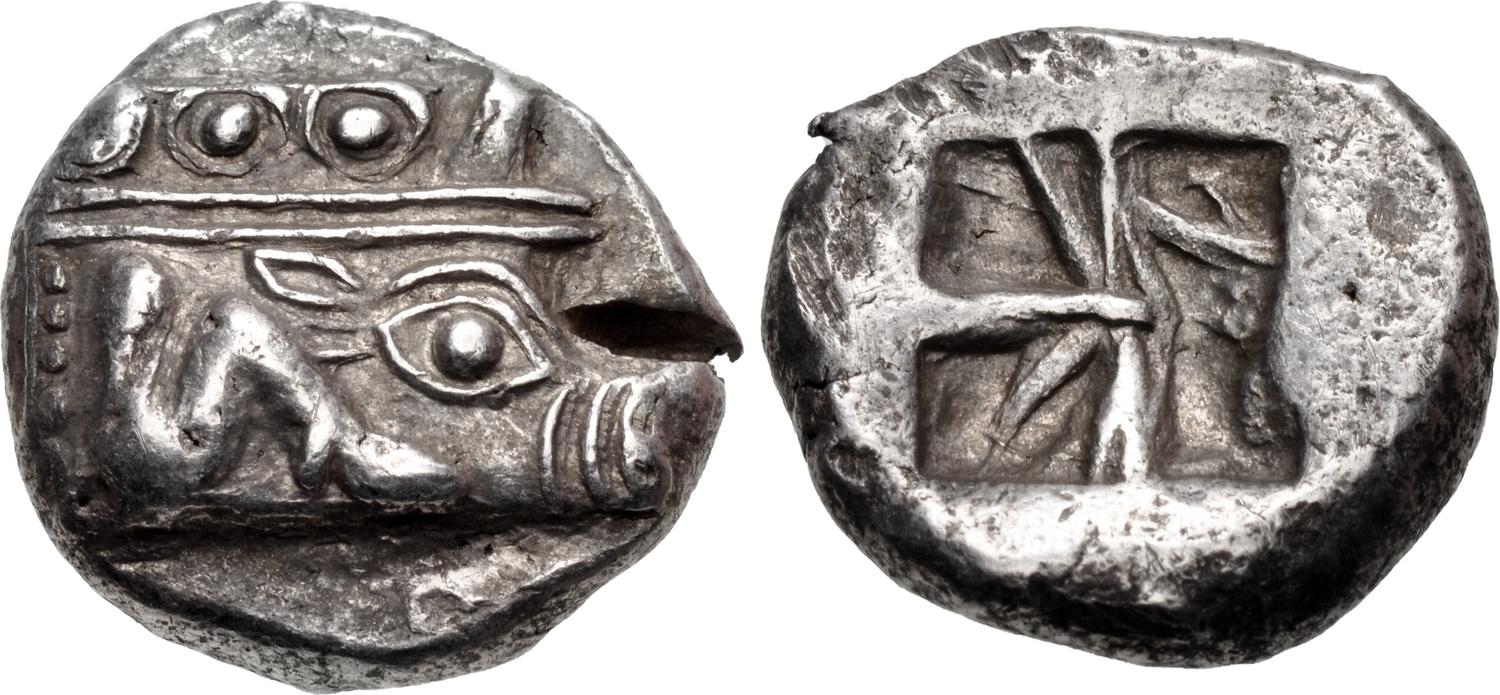Phaselis, silver, double sigloi (530-410 BCE)
From SILVER
530 BCE - 410 BCE Silver 7,161 kg
Description
| ObverseInscription or printing placed on the obverse.: | Prow of galley right, terminating in a boar's forepart, [below, small dolphin right]. |
| ReverseInscription or printing placed on the reverse.: | Incuse square with irregular lines. |
Mint and issuing power
| MintIdentifies the place of manufacture or issue of a numismatic object.: | Phaselis | Ancient regionAncient region.: | Lycia | Modern countryModern country: Turkey | AuthorityIdentifies the issuing power. The authority can be "pretended" when the name or the portrait of X is on the coin but he/she was not the issuing power. It can also be "uncertain" when there is no mention of X on the coin but he/she was the issuing power according to the historical sources: | Persian Empire |
Chronology
| FromIdentifies the initial date in a range assigned in a numismatic context. | 530 BCE | toIdentifies the final date in a range assigned in a numismatic context.. | 410 BCE | PeriodTime period of the numismatic object.: Archaic and Classical |
Physical description
| MetalThe physical material (usually metal) from which an object is made.: | Silver |
Median weightMedian of the weights of numismatic objects (in grams). in grams | 11.90 | DenominationTerm indicating the value of a numismatic object. Examples: tetradrachm, chalkous, denarius.: | stater |
StandardStandard.: | Persian |
Image

AC261 Phaselis.jpeg [1]
References
| Die study referencePublication of the study: | Heipp-Tamer 19931Heipp-Tamer 1993, n° 3-40, p. 129-30, pl. I-III. | ||
| Coin series referenceReference to coin series study: | Sear II2Sear II, n° 3583-3586, RQEMAC3RQEMAC, n° 261 | ||
| Coin series web referenceCoin series web references: | |||
Obverse dies distribution
| FrequencyFrequency of specimen in distribution. ᵖ | Number of obversesNumber of obverse dies. ᵖ (o) | % (o) | Number of coinsNumber of coins. (n) | % (n) | Die nameName(s) of the die(s). |
| 1 | 9 | 39.13 | 9 | 13.85 | 4, 6, 7, 8, 10, 15, 16, 17, 24 |
| 2 | 2 | 8.7 | 4 | 6.15 | 14, 22 |
| 3 | 5 | 21.74 | 15 | 23.08 | 5, 9, 11, 18, 23 |
| 4 | 5 | 21.74 | 20 | 30.77 | 12, 13, 19, 20, 21 |
| 7 | 1 | 4.35 | 7 | 10.77 | 3 |
| 10 | 1 | 4.35 | 10 | 15.38 | 25 |
| Total | 23 of 23 | 100.01 | 65 of 65 | 100 |
Reverse dies distribution
no distribution is available
Quantification
| Number of obversesNumber of obverse dies. ᵖ (o) | 23 | Number of singletons (o1)The number of singleton coins. ᵖ | 9 |
| Number of reverse diesNumber of reverse dies. (r) | 33 | Number of coinsNumber of coins. (n) | 65 |
| Coins per obverse dieNumber of coins per obverse die. (n/o) | 2.83 | Coins per reverse dieNumber of coins per reverse die. (n/r) | 1.97 |
| Reverse per obverse ratioRatio of obverse dies divided by reverse dies. (r/o) | 1.43 | Percentage of singletons (o1)number of coins (n) divided by the number of singletons (o1) ᵖ | 39.13 % |
| Original number of dies (O) (Carter 1983 formula)The estimation of the number of coins according to Carter 1983 ᵖ | 30.09 | Coins struck if 20,000 as average productivity per dieCoins made if the average productivity for obverses (according to Carter) is 20,000. ᵖ | 601,800 |
| Original number of dies (O) (Esty 2011 formula)The estimation of the number of coins according to the singleton formula in Esty 2011 ᵖ (O) | 35.6 | Survival rate if 20,000 as average productivity per dieSurvival rate if average productivity is 20,000. ᵖ | 0.00011 |
| Coverage (o = % of O) (Esty 1984 formula)Esty 1984 - coverage (% of O) ᵖ (o = % of O) | 86.15% | Die productivity if survival rate 1/2,000Average productivity if survival rate is 1/2,000. ᵖ | 4,320.37 |
| Weight of silver (in kg) if 20,000 coins per die (O = Carter formula)Carter 1983 * Median weight * 20000 (*10 if gold or electrum) ᵖ | 7,161 kg <br /> 7,161 kg | Die productivity if survival rate 1/5,000Average productivity if survival rate is 1/5,000. ᵖ | 10,800.93 |
Remarks
Likely military